As a freelancer, how you price your work has a huge impact on your career.
Charge too much, and you may not get enough work to stay busy. Charge too little, and it’s easy to end up working all the time for very little payoff.
Then there’s the detail of how you charge. Do you want the predictability of hourly rates? Or are you willing to take the risk of fixed prices and package deals, in order to potentially earn higher hourly rates? All these approaches have different pros and cons that are important to work through before making a decision.
This guide attacks pricing from a number of angles. First, we’ll help you to find your minimum rates - the lowest rate you’ll accept in order to keep the lights on and compensate you for the risk of running a business.
Then we’ll work through three pricing models: hourly rates, fixed rates, and packaged deals.
Then at the end, we’ll talk about setting your price based on value, and how you can estimate the value you’re adding. Finally, we’ll talk about the thing that every freelancer wants to do but few manage to do: raising your rates (without losing too many clients).
At the end, we’ve included links to a few external sources that you can use to go into more detail on pricing. We’ve included quotes from these sources throughout the guide.
Enjoy!
1: Setting your minimums
The very first thing you need to know about pricing is your minimum. This is the lowest amount you can charge per hour, per project, per week, or however you want to structure your business, in order to pay your bills and earn the kind of money you want to earn.
This sets a floor for your pricing conversations in the future. It’s important to have a clear idea of this figure, because it “anchors” your price negotiations. If a potential client’s budget is below this figure, you can instantly decline, rather than work through a complicated negotiation only to find yourself earning less than you need to live on.
To start, you’ll need to know the answer to this question:
How much money do you want to make?
You need to figure out how much money you want to make per year. This number is entirely up to you, but a good place to start is to try and figure out how much you would make doing the same work as an employee. Then, add a hefty percentage on top of that. This is to compensate for:
- The risk you’re taking by not agreeing to work with the same person every day.
- The costs you incur that you wouldn’t incur as an employee (a laptop, a desk, any equipment)
- Your profit! (Remember, you’re a business - you’re just both the owner and the one employee of that business)
Of course, you might value the flexibility of self-employment enough that you’re willing to make as much or less than you would as an employee. That is okay too! You can structure this however you want, but it’s important to work through the tradeoffs because this is what will inform your pricing decisions further down the track.
Divide your figure
Once you’ve arrived at an annual figure, start dividing it down into chunks. Your goal here is to find a monthly, weekly and daily rate. Remember to account for things like annual leave, public holidays, and seasonal fluctuations in your workload. For example, if you provide services to lots of corporations and government organisations, your summer will probably be reasonably slow - especially around Christmas. If you’re a wedding photographer, your summers will probably be very busy!
So allow for this, and come up with how much you need to make for each month of the year. Depending on the types of contracts you get, or the type of work you do, you may want to take this to an even more granular level - even down to the day!
But no matter how far down you choose to go, you now have something to work with.
An example
Let’s say you want to make $60,000 a year. That is an even $5,000 per month. Assuming no public holidays, you have around 20 working days per month. This means that if you don’t want to work weekends, you need to make $250 per day.
Of course, this might be an average figure. You might make nothing on Monday, then $500 on Tuesday. But you now know that, more or less, you need to have $250 of work committed to every day.
Now you have something to work with.
Look at the time available
One of the stark realities of freelancing is that you aren’t going to be productive 100% of the time. You might be working 40 hours (or more) per week, but not all of those hours are going to be spent working for clients on projects you can charge for. You’ll need to do admin like invoicing and expenses, you’ll need to do business development, you’ll need to prepare quotes for potential clients. All of this stuff takes time.
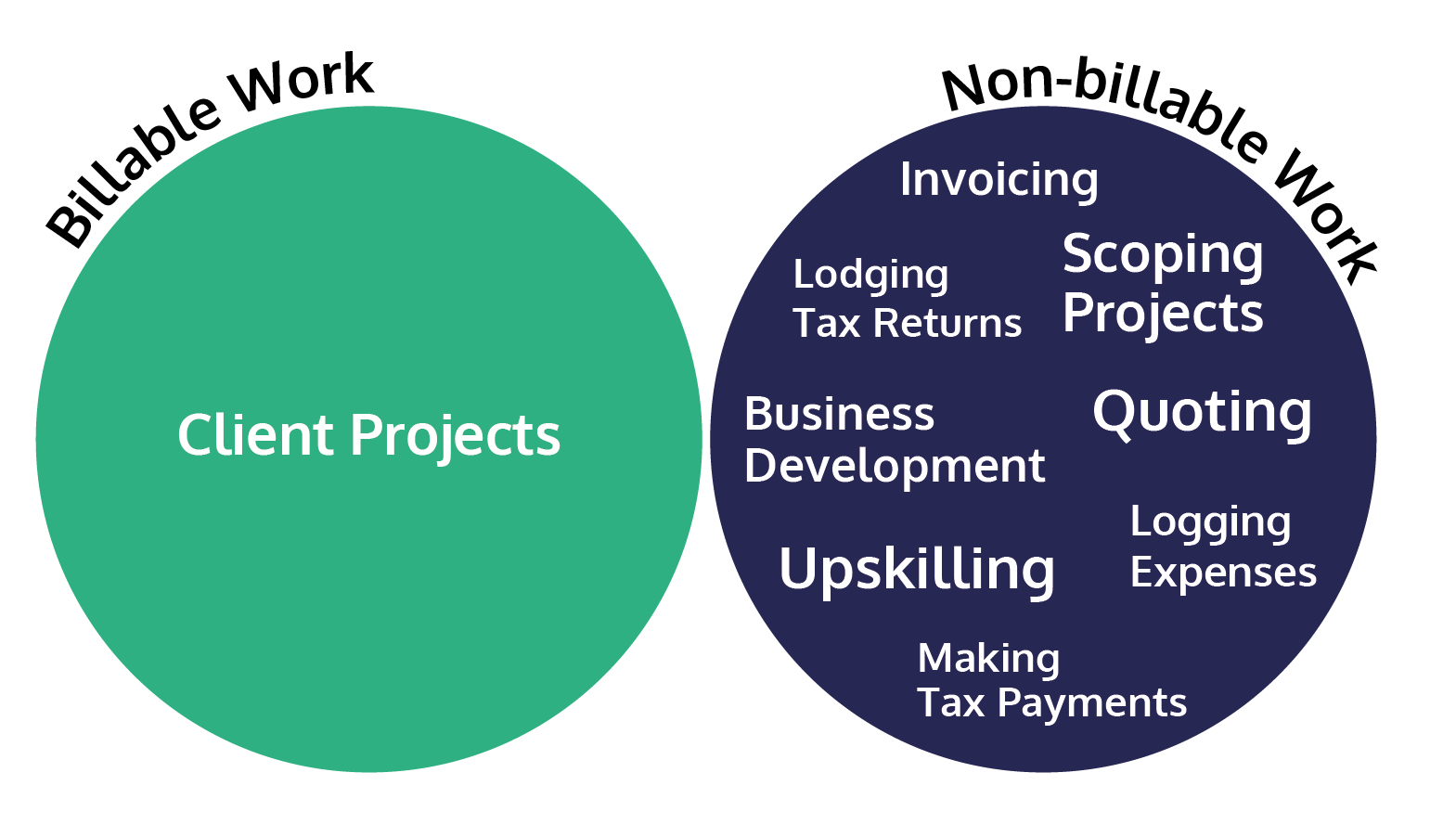
Be generous when you estimate how long all the non-billable work will take. This gives you more “headroom” in your time spent on client work - if you estimate you’ll spend half your time on non-client work and half your time on client work, but end up spending ¾ of your time on client work, you’ll end up making more than you’d budgeted for. That is much better than the alternative of underestimating how much time you’ll spend on non-client work.
Now you have a number
Now you have a number. Well, two numbers actually. One is how much you want to make per week. The other is how much time you have each week to make that money.
The next step is to find your target hourly rate:

This is your starting point for pricing. If you go with an hourly model, you now know how much to charge per hour. If you’re going to go with a packages model, then you know what to price your packages at - and how many you’ll need to do per week. And if you go with a fixed price model, you now know how to price a week’s worth of work.
Here’s a really important point about that number, though: it is a floor not a ceiling. The number you have arrived at sets a bare minimum you can charge; it is not a maximum. In fact, you shouldn’t be afraid to charge more than this figure. We’ll get into that in a lot more detail later on.
2: Charging by the hour
Charging by the hour is the first pricing model we’ll look at. It’s great for:
- Open-ended engagements
- Those who are new to freelancing
- Those who don’t want the risk of charging a fixed fee
But it also has a few drawbacks. In this chapter, we’ll outline some reasons to use hourly pricing - and when to avoid it.
Why charge hourly rates?
The big drawcard of hourly rates is predictability of income - you always know how much your time is worth and how much you’ll earn given a certain amount of work. If you work 20 hours and charge (for example) $50 per hour, you’ll make $1,000. When you know exactly how long you’re going to work, an hourly rate gives you clear expectations for how much income you will earn.
This makes it much easier to regularly hit your daily or weekly income targets. All you need to do is divide your weekly target by the number of hours you want to charge out, then fill those hours with client work. If you can find enough work to fill the hours, then you’ll hit your targets.
Another benefit of hourly rates is that you can just get to work immediately. If you’re charging fixed prices, there’s a lot of admin work up front. You need to negotiate with clients to determine how much you’re going to do; for what price; what’s in scope; and what’s out of scope. This can be time-consuming, and generally isn’t worth it for smaller projects.
Hourly rates are great for engagements that don’t have a clear scope. If you’re in a “you don’t know what you don’t know” situation, where you need to help a client solve a problem, but you don’t really know how big that problem is or how long it’s going to take to solve, then it can make a lot of sense to charge an hourly rate. Otherwise, it’s hard to accurately estimate a price for the project. What’s more, it’s basically impossible to put together a clear scope for these projects, because you don’t know what they’re going to look like.
This is one reason why lawyers often use hourly rates - it’s extremely hard (if not impossible) to guess ahead of time how much effort a case or other legal project is going to take. Charging by the hour means lawyers don’t have to sit and try to figure this out; they can just get to work.
Why avoid hourly rates?
But hourly rates aren’t perfect. The main drawback of hourly rates is that they do not reward efficiency.
Let’s say you’re a graphic designer. You have a client who you’ve been working with for a few years. Every month, you design a landing page to their campaign for that month.
As time goes on, and you become more familiar with their brand, their style, and their product, you’re going to get faster. You’ll also get more efficient at design work in general as you get more experience!
In this case, if you charge an hourly rate, you’re actually going to lose money as you get faster!
As an example, let’s assume you have 20 billable hours per week, charge $100 per hour, and at your current efficiency you can complete a project in 4 hours. That’s 5 projects completed per week giving you $400 in revenue per project.
As you become more efficient - under hourly pricing - here is what happens to your revenue per project.
Revenue per project as you become more efficient
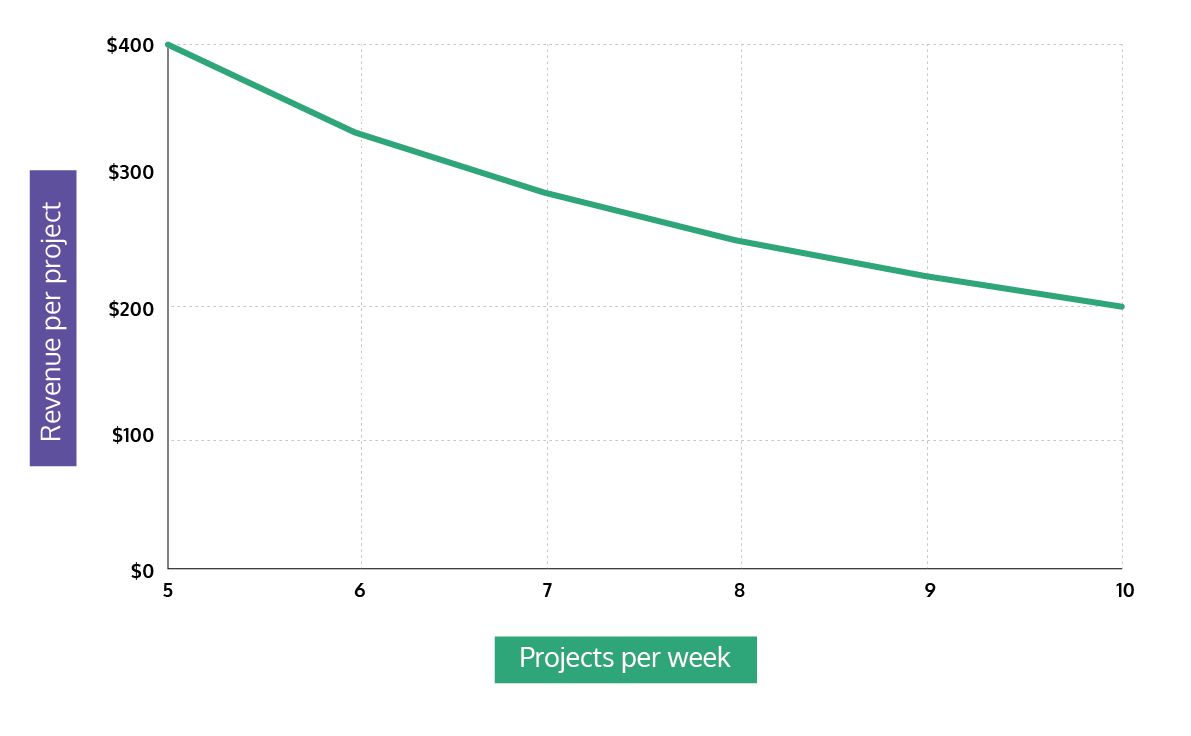
This is not really fair, because you’re producing just as much - if not more - value as you were in the past. But your only option is to raise your hourly rate, which can get kind of messy. Do you raise it just for this client? Do you raise it across the board?
The other problem is that hourly rates set the tone for your relationship with your clients. When you charge an hourly rate, your client is effectively buying your time whenever they hire you - not buying the product you create, or the outcome you deliver.
This is a bit of a problem for your business, because you’re not just selling time. Time is essentially a commodity. If your client sees you as someone who sells time to them, then it’s hard for them to justify not finding someone else who will sell the same amount of time at a cheaper rate.
Finally, hourly rates can become an issue if you want to raise prices further down the track. Once you’re able to really produce quality work, efficiently, you may be better off charging fixed rates - because if you charge equivalent hourly rates, those rates are going to be really high. Clients might balk at paying an hourly rate of $300 or more, even if the total price is very affordable. So you can “hide” that hourly rate in a fixed price (more on that later).
Here’s a quick summary of the pros and cons of using an hourly rate as a freelancer.
Pros and cons of charging by the hour
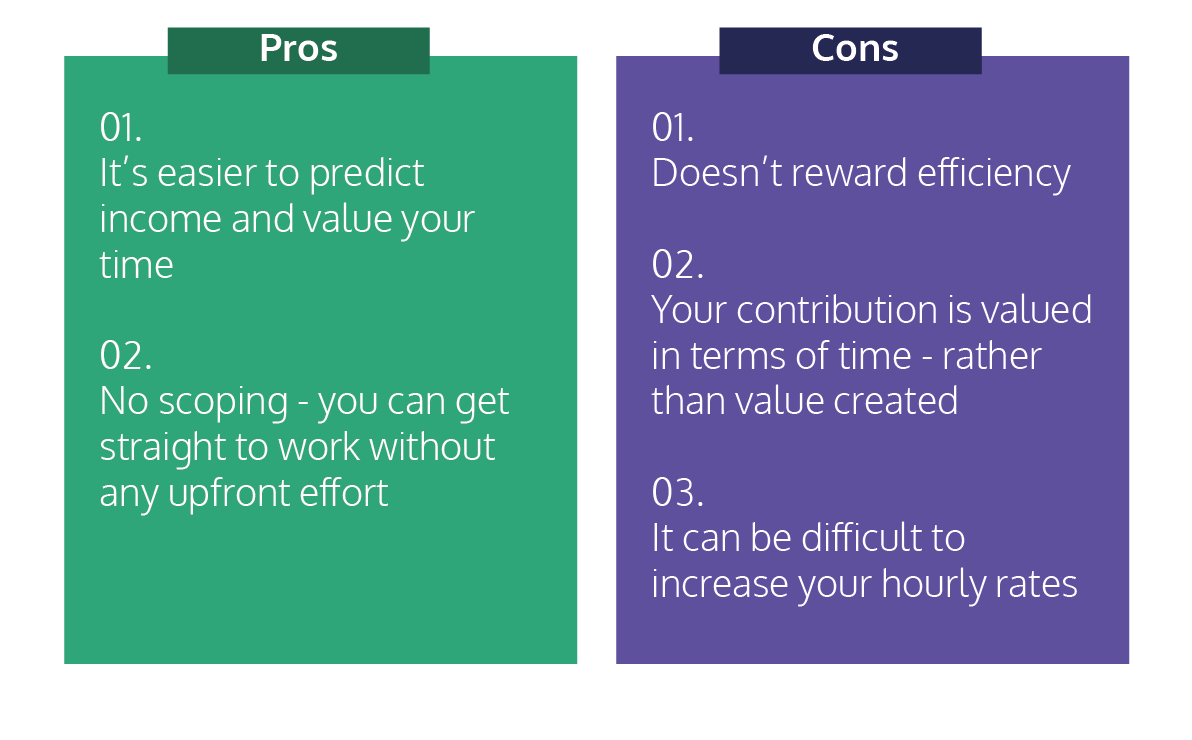
A good choice for most early on
Hourly rates are often a good place to start early on in your freelancing career. When you’re just starting out, you need to figure out where your work is going to come from, what kind of work you’re going to focus on, as well as getting all those background things set up (like a Hnry account!).
At the same time, hourly pricing is simple. You choose an hourly rate. You give an estimate based on that rate. You work, deliver a product, send an invoice. This saves up your time and energy for all those other things you need to focus on when you’re getting started.
But as you develop your business, and become more efficient and valuable to your clients, it might make sense to start looking at other ways of charging. There are, of course, lots of good use cases for hourly pricing - but if you’re sticking with an hourly model, make sure you’re doing so for the right reasons, rather than just doing so because it’s the way you’ve always done things.
Calculate your hourly rate
3: Charging a fixed rate
Fixed rate pricing is exactly what it sounds like - it’s a specific piece of work for a set price. This pricing model is usually suited to freelancers who have been in the game for a few years and have some experience under their belts.
The main positives about a fixed-price arrangement are:
- More income certainty for your business
- Potential to earn higher hourly rates
Hourly rates, in reverse
Hourly rates offer predictable income rates, but they don’t reward efficiency. If you try to work on client work for 20 hours every week, and you estimate that a project will take 20 hours, you probably won’t schedule anything else for that week.
But what happens if you work faster than you expected, and deliver the project in 15 hours? If you can’t pull another project forward to fill the gap, you’re going to be short 5 hours of your hourly rate.
This is how fixed rates offer you more certainty. Let’s say you want to earn $1,000 per week. If you can book four small projects for $250 each, you are guaranteed to meet your income target - no matter how long they take you. There is a tradeoff here: in exchange for this income certainty, you sacrifice time predictability. We’ll get to that in a second.
Earn more in less time
Again, this is the reverse of hourly rates. When you charge hourly rates, you get paid for every hour you’re working. But if you charge a fixed rate, you get rewarded for completing your work faster.
Let’s say you usually charge $100 an hour, and a typical project takes you 10 hours - so you earn around $1,000. If you change those projects to fixed rates of $1,000, and manage to complete them in 8 hours, then your hourly rate goes up to $125. If you can complete then in 5 hours, your effective hourly rate doubles to $200!
As you become more efficient - under fixed pricing - here is what happens to your hourly rate.
Fixed pricing: Your hourly rate as you become more efficient

Those are the two most compelling reasons to use fixed pricing. The big negative is that you take on more risk.
These are the three risks that come with fixed pricing:
- Risk of pricing too low, and ending up with a low hourly rate.
- Risk of scope creep, where the project becomes bigger than you anticipated - again, dropping your hourly rate.
- Spending too much time on detailed proposals
Pricing too low
This is the big risk of fixed pricing. Go back to that $50/hour example we just talked about. Let’s say you price a project at $500, expecting to take 10 hours to complete it. But this is really just a guess - it is hard to estimate how long a project will take (although it gets easier over time).
If you make a mistake, and you finish the project in 15 hours, your hourly rate just dropped to $33. If it takes 20 hours, your hourly rate will drop to $25.
On top of this, it’s going to be a stressful couple of weeks if you have other work to get to. Not only will you be earning a lower hourly rate than you’d like, you’ll also have to find time to fit in your other projects.
So pricing too low can make fixed price projects stressful and expensive for a freelancer.
Scope creep
The other problem that can come up is scope creep. This is when the initial project you signed up for grows over the course of the project.
The first step towards avoiding scope creep is to have a really tight scope to begin with. Before you start working, be very clear about exactly what you are delivering, and when. You should also be clear about how many revisions your client gets included in the fixed price (if that’s applicable to your industry).
But there’s always a tradeoff to make. If a client asks for something small that was outside of your original agreement, it probably won’t hurt to add it on - you do have a relationship with your client, after all. But at the same time, those small things can add up. Next thing you know, your hourly rate is plummeting and you’re chasing your tail to complete other jobs.
A good way to stay on top of this is to track your time, even if you’re not billing on an hourly rate. This gives you a clear view of how much time you’ve spent on a project, and how much “slack” there is for any extras your client may ask for.
But it’s still a risk! Especially when it’s death by a thousand cuts, with lots of tiny additional changes that add up.
Detailed proposals
This risk is related to the last one. To avoid scope creep, you need detailed proposals. But detailed proposals take time! You need to figure out what your client needs, put together a timeline and clear set of deliverables and put a price on all this. This takes time!
If you don’t account for this time in your price, you can end up in the situation we mentioned above - chasing your tail, earning a low hourly rate. This is especially true if your win rate is low - if you put together five detailed proposals, at three hours each, you’re going to have to recoup those 15 hours right out the gate. That’s tough to take, especially if you only win one or two of those projects.
So you need to find a balance. On one hand, you need to be clear in your proposals in order to limit scope creep. On the other hand, you can’t spend so much time on your proposals that your hourly rate plummets.
The chart below summarises the risks associated with the non-billable work required to make fixed-rate pricing work.
How your time is spend in a fixed rate model

Who is fixed pricing best for?
Let’s quickly summarize the pros and cons of fixed rate pricing.
Pros and cons of a fixed pricing model
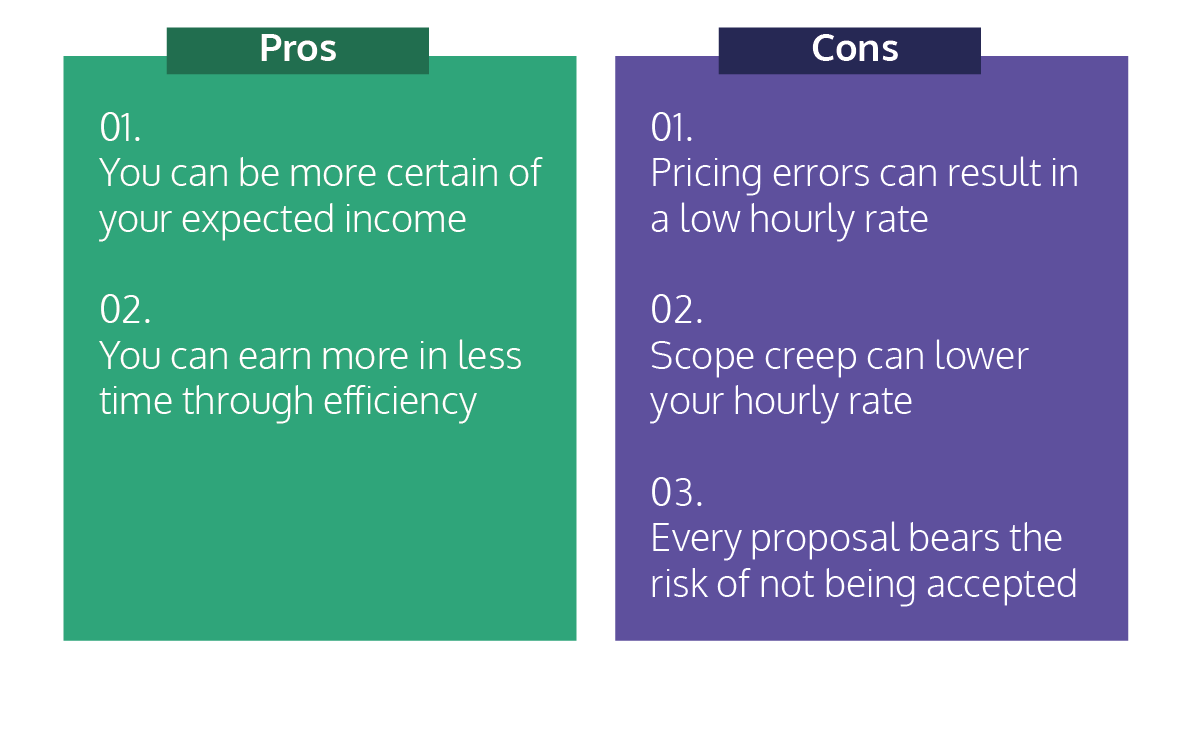
Given what we’ve discussed in this section, fixed rate pricing is best for freelancers with a couple of years of experience. This is for a few reasons.
First, experience gives you a much better idea of how long things take. This is something that you can really only learn by doing, so having a handful of projects under your belt will give you the insight you need to price your projects appropriately.
Second, a couple of years of freelancing will give you access to a lot of old proposals. Once you have these, you can start recycling bits of them into your new proposals. This helps deal with the problem of spending lots of time on each new proposal. When you don’t have to start from scratch on each one, you can save a lot of time, which really helps increase your hourly rate!
On top of this, fixed price arrangements work best for clear, closed-ended projects. They don’t work very well for vague, open-ended projects because these projects are very hard to scope ahead of time. If you’re going into an open-ended engagement, an hourly rate will probably be more suitable.
4: Package deals
Package deals are a way of reducing the time and effort of project scoping. Rather than negotiate a project’s scope with an individual client, you create a pre-defined set of deliverables ahead of time. Then, your potential clients can just choose whether they want these things or not.
It’s a bit like ordering from a menu at a restaurant. When you go to a restaurant, you don’t go to the kitchen and negotiate with the chef about what kind of food they’ll prepare for you, and how much it will cost. Rather, you just have a fixed set of options at a fixed series of prices.
Packaging your services is a similar approach. Like every pricing approach, it has some pros and some cons.
Spreading out your time
The risks and benefits of packaged deals both come from the same place: spending a lot of time up front, in order to (hopefully!) save time down the track.
A package service is basically a proposal that you put together ahead of time. The big difference is that you don’t get to sit down and talk to your potential client about what they specifically need. This is where the risk comes from. If you spend time putting together a packaged service that nobody ends up buying, then that time was wasted.
However, if you put together a packaged service that people do buy, then you get the time saving benefits of having only put together the package once, rather than putting together a series of custom proposals.
Since you’re putting together an entire package rather than an individual project scope, you are probably going to spend more time defining and scoping that package than you would on an individual project. After all, you need to make it compelling (as it will have to stand on its own - you won’t have a conversation beforehand like you usually will with a bespoke project). What’s more, you need to make sure it’s really clear, so people know exactly what they’re getting, and scope doesn’t creep.
Let’s say you usually spend a day putting together a proposal. If you spend five days putting together a fixed-price package, you’ll need to sell that package five times before your time savings are worth it. But if you sell that same package ten times, you will have cut your proposal time per project in half - which means you’re also doubling your hourly rate for that portion of each project!
How is your time spent?
It’s worth looking at where you’re spending your time in a package deals model. This chart should help understand the time efficiencies that you get with this model.
How your time is spent in a ‘package deals’ model
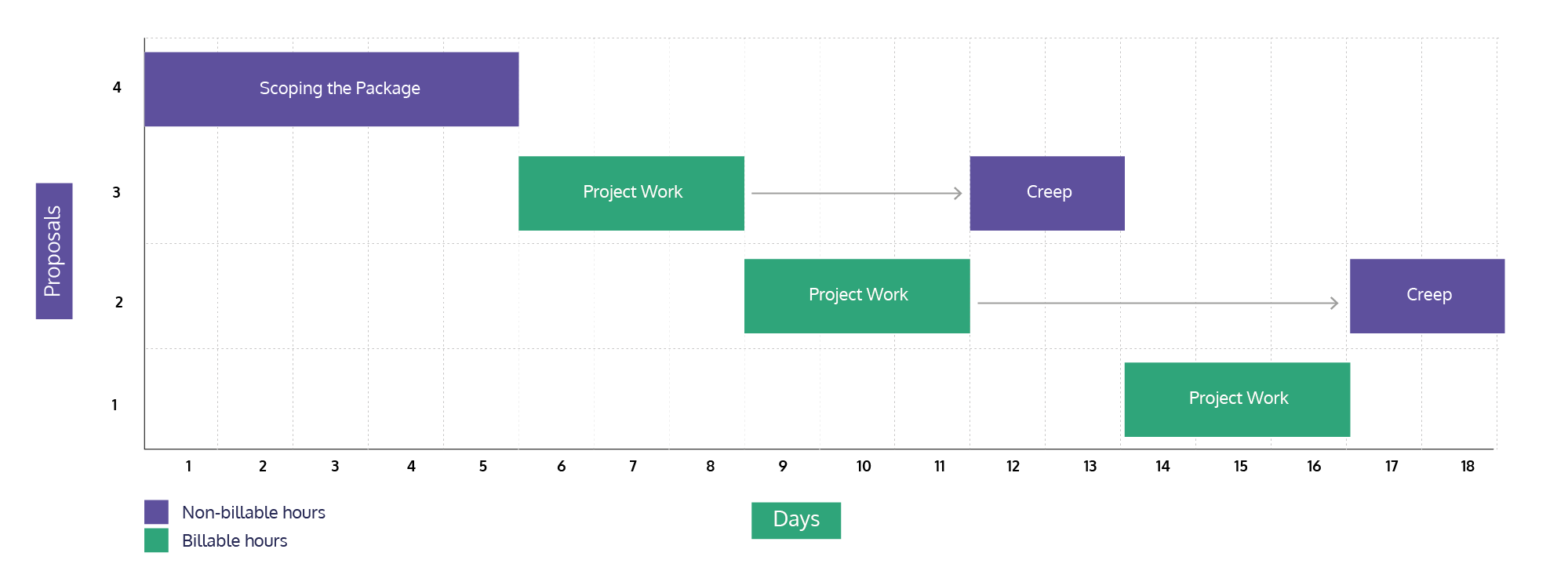
Compared to the fixed price model, you spend more time up front on scoping and packaging the service - before taking it to any potential clients.
Once the scoping is done, however, your return on that time investment is good - provided you get clients to buy the package! Sending a proposal using a package model takes virtually no time at all, and if your package scoping was effective then scope creep shouldn’t be as much of a pain point.
The big risk to this approach has to do with the time you spend scoping. If you misjudge demand for your packaged deal, then you may end up with few (or no) clients taking you up on it, and the time you spent scoping the package was wasted.
Reducing your risk
You can reduce this risk by creating your packages in an iterative way. You can start with broad brush strokes that you offer to existing clients.
If you feel like one of your proposals could appeal to a wide range of clients, then copy that proposal and find another client to send it to - with some modification. Then repeat until you have a proposal that’s optimised and generic enough to be put to the general public. Then you can add things like a landing page on your website, marketing material, and other “bells and whistles.”
A higher hourly rate
In addition to the time savings, there is also a significant upside to packaged services: the ability to increase your hourly rate.
The defining characteristic of a package service is that it is the same thing every time. The more repeatable you can make the project scope, the better.
This means that over time, you can get faster and faster at delivering the same value by selling the same packaged service to multiple clients. You’ll figure out ways to become more efficient, you’ll find which parts of the service clients find the most valuable, and you’ll be able to deliver more value in less time.
This has the practical effect of increasing your hourly rate - and it’s a lot easier to do with packaged deals than it is for fixed price projects, because you’re doing the same thing over and over.
But we’ll talk in more detail about raising your rates later.
For now, let’s review the pros and cons of adopting a ‘package deals’ model.
Pros and cons of a ‘package deals’ model

Who is the ‘package deals’ model best for?
Package deals are best for seasoned freelancers.
Before you can expect to succeed at creating a broadly appealing package offering, you need to have experience scoping, proposing, and delivering similar projects. That experience will tell you:
- How to scope the project in a clear way (reducing scope creep risk)
- How much time it will take you to deliver the project from start to finish (to help you price the project)
- How to get a client excited about the project (marketing)
- What types of clients are looking for these services (marketing again)
Again, you’ll have a backlog of old proposals you can refer to to help you scope and define your packages.
You’ll also notice that two of the above bullet points are marketing related. Experience is essential when it comes to marketing your package deals. An experienced freelancer will have a much better sense of how to sell their work - they’ll also have previous clients they can use for written testimonials, which are a great way of converting prospects into paying customers.
5: Setting your prices based on value
Now that we’ve set a bare minimum (way back in section 1), and worked through some pricing models, we can now look at how you actually set a price.
It’s tempting to just charge a number that will help you meet the figure you arrived at in the first section of this guide. But you may be leaving a lot of opportunities behind if you do this.
Those numbers you figured in your bare minimum cover your costs, which include:the overheads from running your business; the hourly rate you “pay” yourself; and the money you ask for to compensate for the risk of being a freelancer.
Thinking of those figures as costs will help you separate their relationship to the price that you charge your customers. In reality, these costs are only relevant to you. For your customers, the price should be all about value.
Value comes from three places:
- Your ability to increase revenue
- Your ability to cut costs
- Your emotional contribution
You can think of this as a triangle.
The value triangle
How you should think about value from your clients’ perspectives
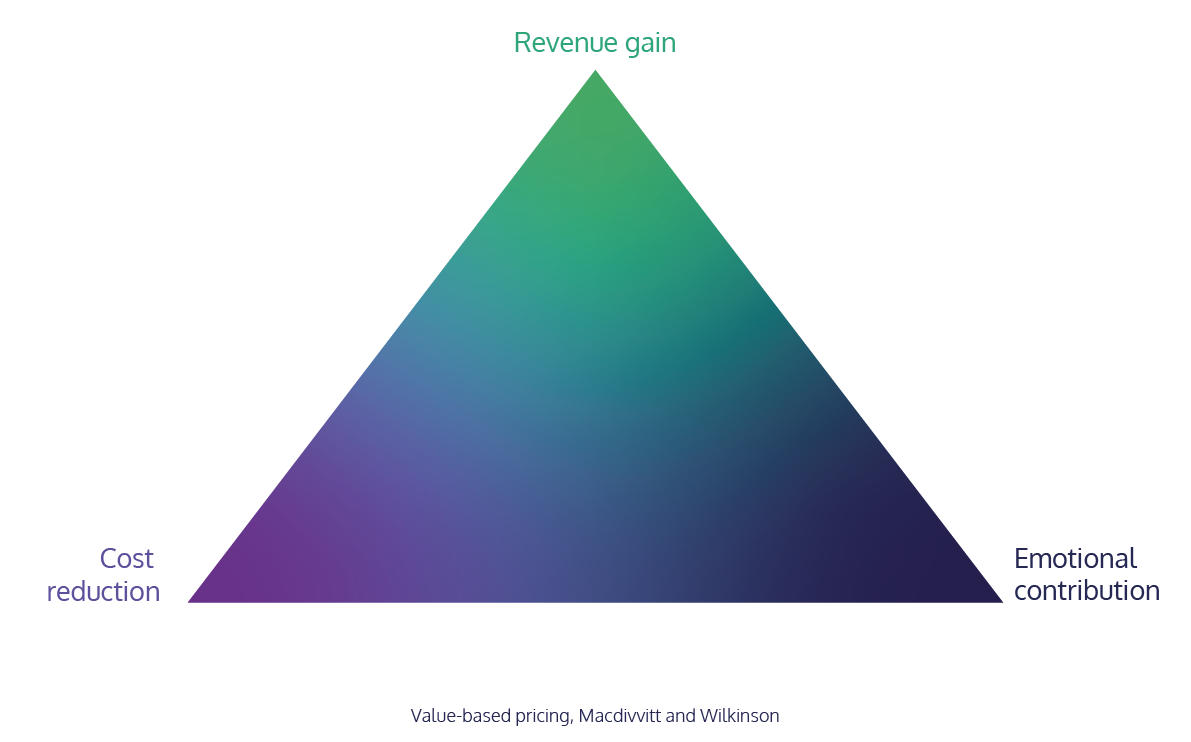
If you take your minimum cost as a starting point, you can use these three factors to charge over and above that number, to gain some of the actual value you create for your clients - rather than just charge a figure that helps to meet your own costs.
All three of these things contribute to value. You don’t necessarily have to have all three as part of what you offer to clients, but you should be sure to position your offer in terms of at least one of these.
If you want to focus narrowly on one, you’ll need to do a really good job of it, as you’ll be vulnerable to other freelancers who can achieve two or three. Conversely, if you choose to do two or three, you’ll need to be careful not to spread yourself too thin.
The key is to be really honest with yourself about which of these areas you are strongest in - and then structure your services around them.
Let’s go over them in more detail.
Revenue gain and cost reduction
These two are fairly self-explanatory. The more you can contribute to your client increasing revenue, and the more you can help to reduce a client’s costs, the more value you are adding. If you can figure this out, or even just estimate it, you can then try to set your price based on the numbers you come up with.
By thinking this way, you can better justify a price you come up with, and move the discussion away from your costs (like your hourly rate) and towards the value you’re actually creating for your client. After all, that’s what they’re buying at the end of the day.
Emotional contribution
This one is harder to quantify, if it’s possible at all - but it’s also arguably the most important of the three pieces of the triangle. It’s the feeling your client gets from hiring you. This could be peace of mind, it could be less hassle, it could be the ability to advance their own career.
These things come less from your work itself, and more in how you conduct yourself. Things like:
- Ability to deliver on time
- How easy you are to work with. Do you respond to emails? Do you huff and puff when briefs change?
- Do you have a good reputation?
The reality is, things like this are going to contribute a lot of value compared to the “bottom line” benefits we talked about before. This makes a lot of sense when you scratch the surface of it. A mid-level person in a corporation or other large organisation is going to be embarrassed if they hire a freelancer who doesn’t deliver on time. That project is their responsibility, and it’s going to be their reputation that suffers.
If one freelancer consistently delivers on time, while another freelancer delivers at random times, but increases revenue a bit more or cuts costs a bit more, the mid-level person is still probably going to go with the freelancer who delivers on time.
So think about your client base, and the emotional contribution you offer them. Consider calling these things out in your pricing - after all, that’s what your clients are paying for.
Justifying your price
Once you have identified how much you will focus on each of these three things, you can use them to justify your price. Rather than just give a price, give a price with an explanation. Explain how your solution is going to do each of these three things, and the value of them.
This approach lets you move away from pricing based on costs (which is limited to your costs) and towards pricing based on value, which is only limited by the amount of value you create for your clients.
6: Raising your rates
If you’re good at what you do (you probably are!), you should be compensated for it.
That shouldn’t sound controversial.
Before you start raising your rates, however, it’s important to understand the economics - the supply and demand - of your business.
Supply is the number of other freelancers who can do the exact same thing as you. The more of them there are, the less you’re going to have to charge to compete. Demand is how badly clients want your services. The more they want to work with you, the more you can charge.
To charge more, you need to have a strong position in at least one of these two factors:
- the supply by offering service that few people other offer, or
- the demand by doing really good work - and telling people about it!
Pricing models and raising rates
Technically, you can raise your rates on any pricing model. Partners in big law firms charge $1000+ an hour without blinking an eye. But in reality some models are more conducive to raising rates than others.
In an hourly model, it can be a bit of a challenge to raise your rates. That’s because once you’re really efficient and provide great value, your hourly rate can get so high that clients won’t be able to see past that number. They’ll balk at paying a high hourly rate, often without realising that your efficiency is built into that rate.
Packages and fixed price offerings are easier models for raising your rates. That’s because your time is an input, not an output. Clients aren’t buying your time - they’re buying the finished product you produce. Your time, plus your skills, plus your experience are all things that go into that finished product.
This is why it’s easier to raise your rates when you’re offering fixed price or package services. When you’re working under these pricing models, your time isn’t a consideration for your clients - all they need to do is figure out if the price you’re charging is worth it to them.
So if you want to raise your rates, your first move should be to move away from hourly pricing. This just makes everything easier.
Address the supply by dominating a niche
You can’t change the number of other freelancers you’re competing against. But you can change the way you position your own business.
Let’s say you’re a graphic designer who does all sorts of things - brochures, web pages, sales presentations - you name it. You’re competing against a huge number of other graphic designers. In other words, the supply of graphic designers is really high. You’re competing against everyone who is offering to do these things.
Completing against all graphic designers

Instead, let’s say you decide to focus on a niche. For the sake of the argument, say you’re going to focus on sales presentations for software companies. By doing this, you have effectively reduced the number of other designers you’re competing against! Now, if a marketing manager at a software company needs a sales presentation designed for the sales team, they know exactly who to call - you are one of just a few people who can solve this narrow problem.
Our premium pricing will cost us clients from time to time; but if we are not losing business on price occasionally, we are not charging enough.
-The Win Without Pitching Manifesto
Competing against a small niche
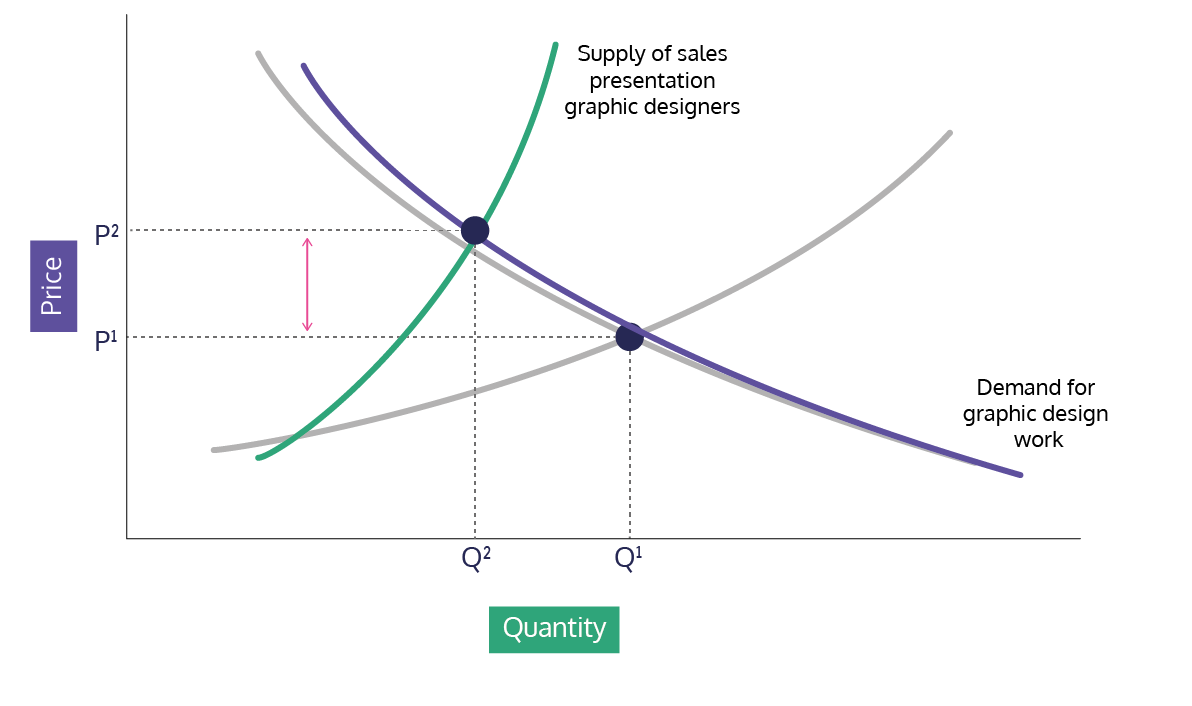
Of course, this is a simplified economic view - in reality there’s a tradeoff here. If you promote yourself as a sales presentation designer, then people may not get in touch with you if they need a brochure or a landing page. Obviously the market’s demand for your niche services will be less than the demand for all graphic design work.
But the trade off could still work in your favour - depending on your industry. As a niche specialist, your work should be valued at a higher rate by members of that niche. If your new niche allows you to raise your rates enough, you should be able to compensate for the smaller amount of work you’ll get.
At the same time, remember that you’re just one person. You don’t need to take on that many projects per month to stay busy.
Address the demand by building your skills
The other side of this is demand. Let’s stick with the sales presentation designer. That designer is still going to have some competition - there will be other designers who specialise in sales presentations, as well as agencies and other freelancers who don’t necessarily specialise, but do offer the same service.
While focusing on a niche helps a bit, that designer also needs to show how they are not just a sales presentation specialist, but is also the best sales presentation specialist. This allows even more room to charge premium rates.
There are a few different ways to do this:
- Make sure your portfolio is up to date with your best work.
- Get proof of results from happy clients, and turn these into testimonials. A nice-looking sales presentation is good, but a client saying you helped increase their sales by a significant percentage is better.
- Put together in-depth case studies showing your process and the results that process achieved.
These things can help to increase demand for your services. And if you can increase demand, you can command a higher price.
Don’t forget the value triangle
When you’re doing this, don’t forget the value triangle. Any testimonials or case studies should be in the context of that value triangle. Someone who reads one of them should walk away with a clear idea of the revenue you generated, the costs you saved or your emotional contribution. Or, of course, a range of these three.
This is how you reliably charge high rates - be very clear about the value you offer, and take deliberate steps to increase that value.
Further reading
Pricing is a big topic. This guide gives you a solid starting point (we hope!) but there’s a lot more out there to help you price your services at the level you deserve.
Here’s a few things to crack into if you want more detail:
PricingPro Crash Course
This is a series of emails about how to price your services as a freelancer. It’s by copywriter Michal Eisikowitz, but the advice in these emails is applicable to any freelancer. The great thing about this course is that it’s free, and a series of emails is a lot easier to digest than a book or longer piece of material.
Value-based pricing
This book goes deep on the stuff we covered in chapter 5 - pricing based on value to the customer rather than your own internal costs.
Be warned: it’s written for big organisations, and gets really in-depth and technical. But having said that, there are some really solid insights to be had - like the value triangle of cost reduction, revenue gain and emotional contribution.
Buy the Kindle version for around $30 here, or a hard copy from local business Fishpond for just short of $60 here.
The Win Without Pitching Manifesto
This short book by Blair Enns is all about the stuff we covered in chapter 6 - increasing demand for your services by showcasing your expertise. This book has 12 “proclamations” for creative agencies to consider - things like “we will be selective” and “we will charge more.”
You can buy the Kindle version of the book for about $10. Or you can sign up to the author’s email list down the bottom of this page.
Pricing Design
This e-book by Dan Mall talks pricing design specifically. It talks about value-based pricing, and has a useful case study on how he actually arrived at a price for a project he quoted. It’s only $10, so may be a better option than Value-Based Pricing if you want to read more, but don’t want to shell out $50 or get into the super-gritty details.
Share on:
